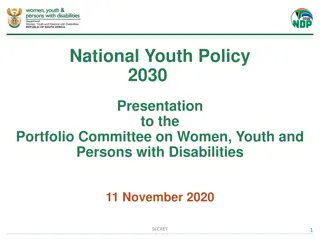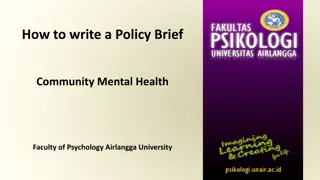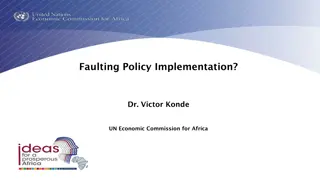Policy Brief_Updated
Design and put infographics
Download Presentation

Please find below an Image/Link to download the presentation.
The content on the website is provided AS IS for your information and personal use only. It may not be sold, licensed, or shared on other websites without obtaining consent from the author.If you encounter any issues during the download, it is possible that the publisher has removed the file from their server.
You are allowed to download the files provided on this website for personal or commercial use, subject to the condition that they are used lawfully. All files are the property of their respective owners.
The content on the website is provided AS IS for your information and personal use only. It may not be sold, licensed, or shared on other websites without obtaining consent from the author.
E N D
Presentation Transcript
HIV Prevention among Adolescents and Youth in Tanzania Frank Eric Hassan
Overview of HIV in Adolescents Approximately 1.5 million adolescents and young people (15-24 years) are living with HIV worldwide. Sub-Saharan Africa Accounts for the largest share Young women are disproportionately affected, making up over 75% of new HIV infections in this age group.
Tanzania HIV Impact Survey (THIS) 1. Tanzania HIV Impact Survey (THIS) 2016-2017 HIV prevalence among 15-24 year olds: 1.4% Males: 0.8% Females: 2.1% 2. Tanzania HIV Impact Survey (THIS) 2022-2023 HIV prevalence among 15-24 year olds: 1.5% Males: 0.6% Females: 2.4%
Challenges in HIV Prevention among AYLHIV In a study done in Tanzania; Only 36.9% of school-going adolescents and youth knew about HIV prevention. 49.0% of school-going adolescents and youth aged 15-24 years reported having ever had HIV testing and received test results. 79.1% of school-going adolescent did not use condoms during their first sexual intercourse.
Challenges in HIV Prevention among AYLHIV Low uptake of HIV testing and counselling. Only 10% of men and 15% of females aged 15 to 24 years were aware of their HIV status. The majority of students (79.1%) did not use condoms during their first sexual intercourse. These results indicate an increased likelihood of risk for HIV transmission among adolescents and youth.
The Problem Comprehensive sexual education (CSE) in schools was implemented, as revealed in the study conducted, where the majority of pupils declared to have been taught about HIV/AIDS and related subjects. Despite being taught, the majority of them demonstrated a very low level of knowledge of HIV/AIDS and prevention.
Policy Gap While the National Adolescent Health and Development Strategy and National Multisectoral Strategic Framework on HIV and AIDS advocate for comprehensive sexual education (CSE) in schools, including Schools to provide students with knowledge on HIV transmission and skills to prevent HIV and Schools to collaborate with health services to increase access to youth-friendly services, The actual implementation is inconsistent.
Policy Option To achieve a reduction in HIV transmission among adolescents, HIV prevention interventions must consider opting for integrated approaches to achieve maximum effectiveness, including rapid HIV testing and behavioural interventions (Hosek & Pettifor, 2019). Success is more likely when programs are also integrated with national sexual health policies to ensure Sustainability, Scalability, Measurable changes in adolescent knowledge and behaviours
OPTION 1 Option 1: Multi-Component Approach - Comprehensive Sexual Education (CSE) should be combined with Peer Education Programs and HIV Testing and Counseling (HTC)) Programs that combine education, access to health services, and community involvement have demonstrated better outcomes in HIV prevention among adolescents. Case Study: Kenya Teacher-led sexual health education, community health worker involvement, and access to youth-friendly health services HIV knowledge increased by 23% There was a 50% reduction in reported risky sexual behaviour (e.g., multiple sexual partners) Condom use increased by 38% among sexually active students. Case Study: Zimbabwe Expanded School-Based Interventions Combining classroom-based education, mobile health services, and community outreach addressed HIV prevention. Integration of health services (e.g., HIV testing and treatment) with school programs increased HIV testing among youth by 45%. A 25% increase in the practice of safer sex (condom use and fewer sexual partners)
Option 2 Option 2 Option 2: Advocate School-based health clinics offering confidential services Case Study: Kenya (Implementation of school-based clinics) A 45% increase in HIV testing A 35% increase in consistent condom use A 30% reduction in teenage pregnancies
Implementation consideration Make sure school-based interventions are aligned with national policies Make CSE a compulsory part of the national school curriculum. Strengthen the link between schools and youth-friendly health centres Involve parents in sexual health education Education should be tailored to specific age groups. School teachers and health care providers should receive comprehensive, integrated health education training. While the inadequacy of human resources is evident, time allocation to implement the activities remains essential.
Key Messages There is a need for governments, schools, and communities to prioritise HIV prevention in adolescents. To achieve a reduction in HIV transmission among adolescents, HIV prevention interventions must consider opting for integrated approaches to achieve maximum effectiveness, including rapid HIV testing and numerous behavioural interventions such as building social skills and networks by connecting school adolescents with peers for age-specific information, emotional and material support.

























